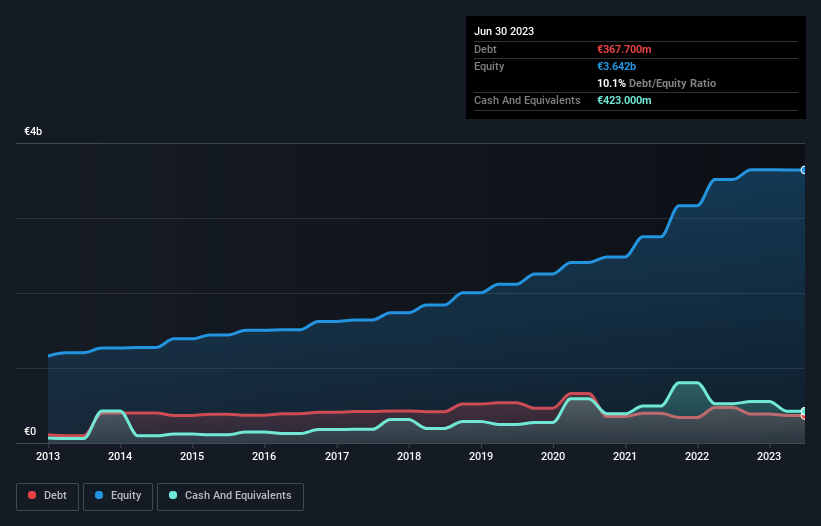- France
- /
- Medical Equipment
- /
- ENXTPA:BIM
These 4 Measures Indicate That bioMérieux (EPA:BIM) Is Using Debt Reasonably Well

Legendary fund manager Li Lu (who Charlie Munger backed) once said, 'The biggest investment risk is not the volatility of prices, but whether you will suffer a permanent loss of capital.' So it seems the smart money knows that debt - which is usually involved in bankruptcies - is a very important factor, when you assess how risky a company is. We note that bioMérieux S.A. (EPA:BIM) does have debt on its balance sheet. But the real question is whether this debt is making the company risky.
When Is Debt A Problem?
Generally speaking, debt only becomes a real problem when a company can't easily pay it off, either by raising capital or with its own cash flow. If things get really bad, the lenders can take control of the business. However, a more usual (but still expensive) situation is where a company must dilute shareholders at a cheap share price simply to get debt under control. Of course, plenty of companies use debt to fund growth, without any negative consequences. When we think about a company's use of debt, we first look at cash and debt together.
View our latest analysis for bioMérieux
What Is bioMérieux's Debt?
The image below, which you can click on for greater detail, shows that bioMérieux had debt of €367.7m at the end of June 2023, a reduction from €472.6m over a year. However, its balance sheet shows it holds €423.0m in cash, so it actually has €55.3m net cash.

A Look At bioMérieux's Liabilities
Zooming in on the latest balance sheet data, we can see that bioMérieux had liabilities of €980.7m due within 12 months and liabilities of €408.7m due beyond that. Offsetting these obligations, it had cash of €423.0m as well as receivables valued at €888.9m due within 12 months. So its liabilities total €77.5m more than the combination of its cash and short-term receivables.
Having regard to bioMérieux's size, it seems that its liquid assets are well balanced with its total liabilities. So it's very unlikely that the €10.2b company is short on cash, but still worth keeping an eye on the balance sheet. Despite its noteworthy liabilities, bioMérieux boasts net cash, so it's fair to say it does not have a heavy debt load!
It is just as well that bioMérieux's load is not too heavy, because its EBIT was down 23% over the last year. Falling earnings (if the trend continues) could eventually make even modest debt quite risky. There's no doubt that we learn most about debt from the balance sheet. But ultimately the future profitability of the business will decide if bioMérieux can strengthen its balance sheet over time. So if you're focused on the future you can check out this free report showing analyst profit forecasts.
Finally, a business needs free cash flow to pay off debt; accounting profits just don't cut it. While bioMérieux has net cash on its balance sheet, it's still worth taking a look at its ability to convert earnings before interest and tax (EBIT) to free cash flow, to help us understand how quickly it is building (or eroding) that cash balance. Looking at the most recent three years, bioMérieux recorded free cash flow of 43% of its EBIT, which is weaker than we'd expect. That's not great, when it comes to paying down debt.
Summing Up
While it is always sensible to look at a company's total liabilities, it is very reassuring that bioMérieux has €55.3m in net cash. So we don't have any problem with bioMérieux's use of debt. The balance sheet is clearly the area to focus on when you are analysing debt. However, not all investment risk resides within the balance sheet - far from it. Case in point: We've spotted 1 warning sign for bioMérieux you should be aware of.
If you're interested in investing in businesses that can grow profits without the burden of debt, then check out this free list of growing businesses that have net cash on the balance sheet.
New: Manage All Your Stock Portfolios in One Place
We've created the ultimate portfolio companion for stock investors, and it's free.
• Connect an unlimited number of Portfolios and see your total in one currency
• Be alerted to new Warning Signs or Risks via email or mobile
• Track the Fair Value of your stocks
Have feedback on this article? Concerned about the content? Get in touch with us directly. Alternatively, email editorial-team (at) simplywallst.com.
This article by Simply Wall St is general in nature. We provide commentary based on historical data and analyst forecasts only using an unbiased methodology and our articles are not intended to be financial advice. It does not constitute a recommendation to buy or sell any stock, and does not take account of your objectives, or your financial situation. We aim to bring you long-term focused analysis driven by fundamental data. Note that our analysis may not factor in the latest price-sensitive company announcements or qualitative material. Simply Wall St has no position in any stocks mentioned.
About ENXTPA:BIM
bioMérieux
Develops and markets in vitro diagnostic solutions for the diagnosis of infectious diseases in the Americas, Europe, the Middle East, Africa, and the Asia Pacific.
Flawless balance sheet and undervalued.


